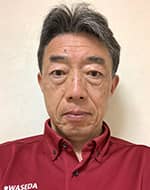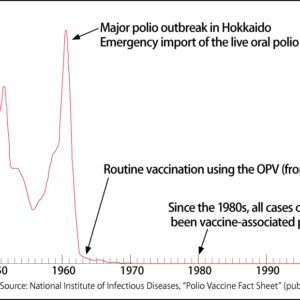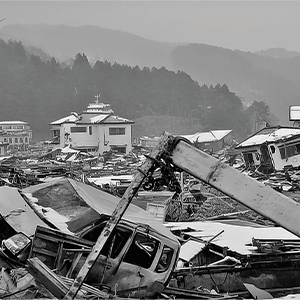The bones of elderly people —— particularly women —— become more brittle with age. This can have an extremely serious impact on daily life if they suffer a fracture due to a fall, for example. Increasing bone density is crucial in order to extend healthy life expectancy. So, how can we do this? In fact, scientists say that being active during our elementary and junior high school period is important. Exercise habits in childhood affect future healthy life expectancy. However, the reality is that many children do no exercise. It is desirable for children to experience various forms of sport and physical play, in order to develop a sense of enjoyment from physical activity.
Special Feature 1 – Sport’s Hidden Depths Exercise in the elementary and junior high school period affects future healthy life expectancy
composition by Takeaki Kikuchi
We have entered an age in which people live to be 100 years old, and there is growing interest in the question of how to ensure people can live healthy lives for longer, rather than merely extending their life expectancy. Maintaining bone density at as high a level as possible is crucial to extending this healthy life expectancy. This is because the risk of fractures as a consequence of falling increases substantially once our bones become brittle.
Dwindling hormone levels cause bone density to plummet
Being active during our elementary and junior high school period is important in order to avoid that risk of fractures. My research focuses on the relationship between exercise during the growth period and health in old age. Muscle strength is, of course, important to enable elderly people to remain healthy. People can gain a certain amount of muscle strength even if they start working on it in old age. To take what might be an extreme example, when he was 65, the explorer Yuichiro Miura set himself the target of reaching the summit of Mount Everest five years later. As a result of changing his diet and training for the expedition, he reportedly managed to gain a decent amount of muscle. But it is virtually impossible to increase bone density in old age. It is something that can only be done when one is young.
So, what kind of changes in bone density take place as we age? The risk of osteoporosis is higher in women, and it is during our growth period that we gain substantial bone mass. It peaks before we reach the age of 20 and remains at roughly the same level thereafter. Once women reach the age of 50 or thereabouts, a pronounced drop in female hormones causes a sharp decline in bone density. These female hormones are estrogen and progesterone, and it is estrogen that is closely related to bone metabolism. It curbs processes that wear bones away and encourages the formation of new bone by sending calcium throughout the body. Consequently, once estrogen secretion dwindles, bone mass declines.
Treatments are available that seek to avert bone loss. The idea behind them is to minimize the reduction in bone density through the use of drugs. However, this cannot really be described as prevention.
Accordingly, research recently being conducted in a number of countries is focusing on efforts to acquire a great deal of bone mass during the growth period, when bone mass increases sharply, and to keep bones stronger than now into old age, even once bone density starts to decline around the age of 50. This approach regards interventions during the growth period as being key (Figure 1).
 Modified from a booklet published by the Japan Osteoporosis Foundation
Modified from a booklet published by the Japan Osteoporosis Foundation
Figure 1. Age and changes in bone mass in womenBy further increasing bone mass through exercise during the growth period, it will be possible to maintain adequate bone mass into old age, even once the postmenopausal decline occurs.
We conducted a more detailed survey to identify when the biggest increase in bone mass actually occurs. Data originally emerged from an overseas study, showing that this increase occurs between six months and a year after the biggest increase in height among both boys and girls. Our survey also yielded the same results, demonstrating that the biggest increase in bone mass occurs around the ages of 13-14 in boys and 11-12 in girls.
It is at this time, when bone mass is increasing, that appropriate nutrition and plenty of exercise are thought to be necessary. Applying stimulus above a certain strength to bones is key to increasing bone mass.
Exercise during the elementary school period has a major impact for women
What happens to the bone density in old age of people who did plenty of exercise in their youth? There is a deeply interesting study that investigates this question.
In Japan, there has been an ongoing study that measures the physical strength of athletes who competed in the 1964 Tokyo Olympics. The physical strength of these Olympians is measured once every four years, in the Olympic year. The most recent survey was carried out in 2016, as the COVID-19 pandemic prevented the 2020 survey from taking place.
Measured as part of the study, the Olympians’ bone density is astonishingly high. Measured against the average of 100 for individuals aged 20-44 —— known as the young adult mean (YAM) —— the most common result for men was in the 100-104 range, followed by 105-109. This means that, in a survey conducted more than half a century later, most of the men who competed in the Olympics have a higher bone density than the average for people in their 20s to 40s. In the case of female Olympians too, not one of the 26 subjects had a YAM below 80%, which is considered indicative of bone loss, let alone below the 70% threshold indicating osteoporosis.
You might think that Olympians are a special case, but even among more typical people, exercise in childhood undoubtedly has a positive effect on bone mass during old age. We conducted a survey of bone density in elderly women who enjoy sport. With the cooperation of women aged 64 and older —— including some in their 80s —— who play soft volleyball, we sought to investigate the relationship between exercise when they were young and their current bone density.
We divided them into three groups: those who had exercised when young, those who did not exercise when young but had enjoyed it, and those who had not exercised when young because they had disliked it. Our study showed that those who had exercised when young had the highest bone density, followed by those who had not but had enjoyed it, and finally those who had disliked exercise.
We then investigated when they had done exercise and their bone width. The question of whether one’s bones are wide or narrow is an important one —— we can liken it to the question of whether or not a house has a framework of thick structural pillars. It was apparent that, while there is little difference in bone width between those who did and did not exercise during their junior and senior high school period, those who had exercised during their elementary school period tended to have wider bones. This shows that exercise during the elementary school period have a substantial impact in the case of women. We have not conducted a similar study of men, but even when we consider the different timing of the increase in bone mass arising from differences in growth patterns between males and females, it seems likely that exercise through to the junior high school period has considerable significance.
The amount of exercise during the elementary and junior high school period thus has a major impact on future healthy life expectancy. However, unfortunately, the reality is that many children do not exercise during this crucial period.
The Japan Sports Agency of the Ministry of Education, Culture, Sports, Science and Technology publishes the results of a study it conducts regarding the total time spent on exercise per week by elementary and junior high school students. The survey asks how much time children spent doing exercise each week outside physical education classes, with respondents choosing one of four answers: 0 minutes; 1-less than 60 minutes; 60-less than 420 minutes; and 420 minutes or more. Many respondents choose either 0 minutes or 1-less than 60 minutes (Figure 2).
 From the results of the FY2022 Survey on Physical Fitness and Motor Abilities (Modified from the Japan Sports Agency website)
From the results of the FY2022 Survey on Physical Fitness and Motor Abilities (Modified from the Japan Sports Agency website)
Figure 2. Distribution of total exercise time per weekIt is desirable for children to spend at least 420 minutes per week engaging in exercise outside physical education classes. However, many children spend less than 60 minutes per week on such exercise, with some reporting figures as low as zero.
According to the FY2022 survey, the percentage of children choosing the response 0 minutes was 4.3% among male and 5.8% among female elementary school students, and 5.8% among male and 12.3% among female junior high school students. Although the low level of exercise among junior high school girls stands out, this actually is a considerable improvement on previous surveys. Ten years ago, as many as 25% of respondents in this group chose 0 minutes, which shocked those connected to this field. As a result of subsequent guidance in educational settings, the figure has at last come down to 12.3%.
420 minutes of total exercise time per week is one benchmark. Various countries around the world recommend that children should spend an average of at least 60 minutes per day engaging in physical activity. If we look at the percentage of children choosing the response 420 minutes or more, the figure was 50.1% among male and 29.2% among female elementary school students, and 78.1% among male and 57.7 % among female junior high school students. The reason why the figures for junior high school students are higher than those for elementary school students among both boys and girls is probably because of activities as part of extracurricular clubs at school. We can see a polarization during the junior high school period, between children who exercise and children who do not.
Positive effects on eating habits and sleep as well
Time spent exercising does not only have an effect on healthy life expectancy several decades later. It probably goes without saying that there is a direct link to current physical strength, but there is also presumed to be a positive impact on lifestyle. In comparisons of children who exercise with children who do not, children who do exercise also score better on figures relating to diet and sleep.
In addition, my laboratory has investigated the relationship between the time children spend exercising and their quality of life (QOL). We used the Japanese version of the PedsQL Pediatric Quality of Life Inventory —— a yardstick for measuring children’s health-related QOL consisting of four scales (physical functioning, emotional functioning, social functioning, and school functioning), in which a higher QOL score indicates that the child has a positive outlook on their overall daily life —— to conduct a survey among 306 junior high school students aged between 12 and 15 (166 boys and 140 girls). The results showed that children who spent more time exercising each week had a higher QOL score. Looking at the children who spend little time exercising, while some had a high QOL, a very large number had low QOL scores. The number of children with a low QOL score declined as the length of time spent exercising increased (Figure 3).
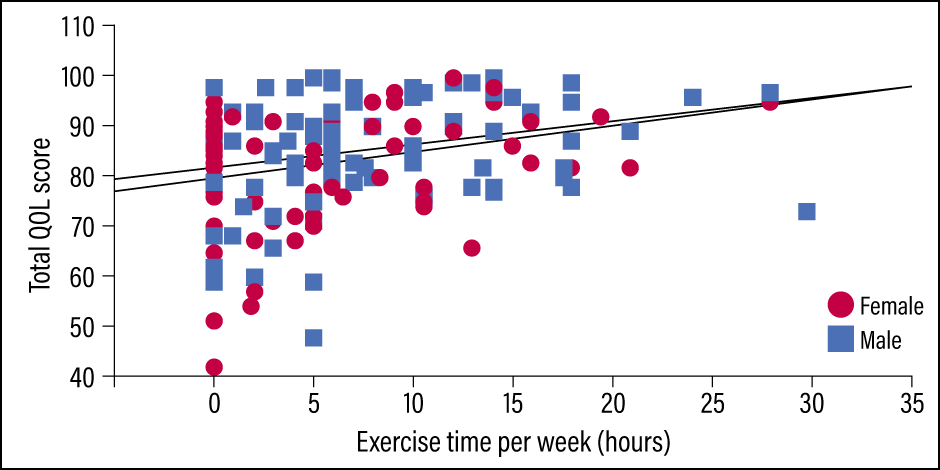 From a survey by the Sports Medicine TORII Lab., School of Sport Sciences, Waseda University
From a survey by the Sports Medicine TORII Lab., School of Sport Sciences, Waseda University
Figure 3. Relationship between exercise time and QOLMany of the children who spend little time exercising have a low QOL. The number of children with a low QOL decreases as time spent exercising increases, and average values also rise.
As described above, time spent exercising refers to time spent being active outside of physical education classes, so it includes physically active play like tag. To increase bone density, it is necessary to apply stimulus to bones. Games such as jump rope, elastic jump rope, and hopscotch are very good in this regard, but these days one hardly ever sees children playing games like these. This may well be because they spend more time fiddling with smartphones and playing video games. But in order to improve both future healthy life expectancy and current QOL, I would like to see children engaging in physically play.
While there are various conceivable reasons why children do not exercise, there is also a close relationship to their feelings about physical education. When we divided the children into four groups according to whether they “really liked,” “somewhat liked,” “did not much like,” or “disliked” physical education and then investigated how long they spent exercising, we found that, as expected, the children who liked physical education spent the most time exercising. In addition, we found that the children who liked physical education had a lower body mass index (BMI) and a higher bone density than the children who disliked it.
A survey of 1,000 women aged 50 and older conducted in 2021 by the Public Relations Committee of the Japanese Orthopaedic Association found that feelings about physical education influenced engagement with exercise throughout the subjects’ lives. In the 50s, 60s, and 70s age brackets alike, the current frequency of exercise was higher among those who had liked physical education during their elementary school period.
This survey also investigated the stage at which women aged 50 and older began to dislike physical education. It found that the number of people who started to dislike or somewhat dislike physical education increased with the progression from elementary school to junior high and then senior high school. In addition, the number citing the teacher as the reason for their dislike also increased with the progression from elementary school to junior high and then senior high school (Figure 4). It is therefore necessary to devise ways to make physical education enjoyable for children, to ensure that they do not develop a dislike for exercise.
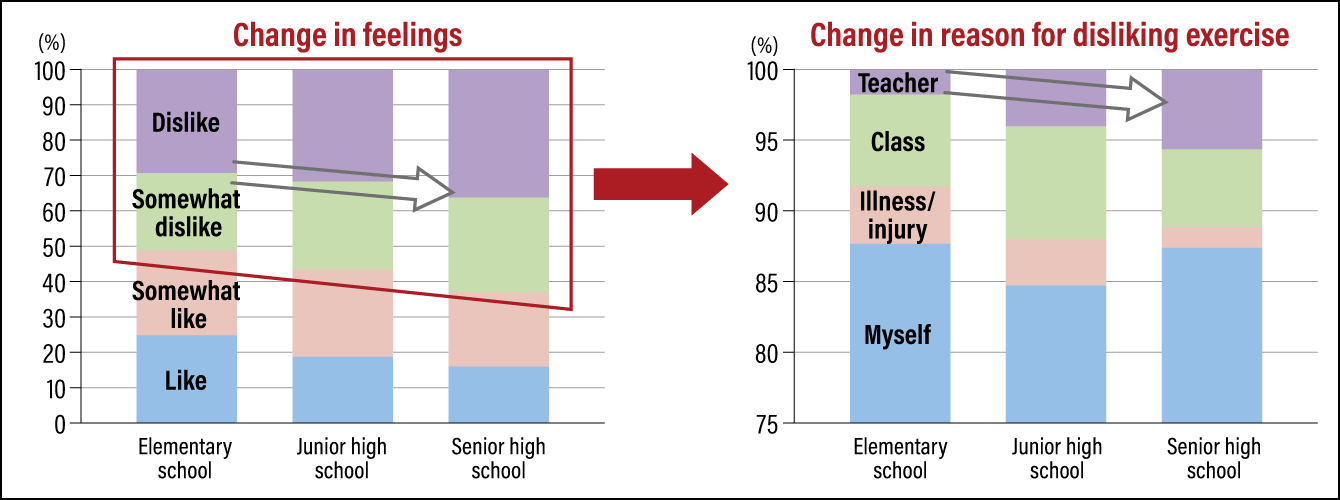 From a survey by the Public Relations Committee of the Japanese Orthopaedic Association
From a survey by the Public Relations Committee of the Japanese Orthopaedic AssociationConducted in July 2021
Figure 4. Feelings about physical education in childhood: A survey of attitudes among 1,000 women aged 50 and olderWhen we look at the stage at which women aged 50 and older began to dislike physical education, we can see that the number who disliked it increased with the progression from elementary school to junior high and then senior high school. While most stated that the reason lay in themselves, in that they never liked exercise in the first place or were just not very good at it, the number citing the teacher as a factor increases with the progression through the school stages.
Why extracurricular club activities are not necessarily good
As we saw earlier, in a survey of the total time spent exercising by junior high school students each week, the amount of exercise was polarized on the basis of whether or not the students took part in extracurricular club activities. From the perspective that the more time spent exercising the better, one would conclude that giving one’s all to extracurricular sports club activities would be a good thing. However, there are aspects where one cannot necessarily say this is the case.
In Japan, when students take up a particular sport, they focus only on that sport, practicing it intensively and repeatedly. This places a major burden on specific parts of the body. Let us look at an example by way of explanation. In the case of baseball, repeatedly pitching a ball every day inevitably makes a person prone to elbow and shoulder injuries. It is vital to avoid placing a burden on specific parts of a growing body, where the bones are not yet solid. Thus, even the sports that we think are good for us can have a negative impact on the body.
With the cooperation of Waseda University’s sports clubs, we measured bone density and length in athletes belonging to each club. We also compared their dominant and non-dominant arms. In the case of baseball players, bone density was higher in the dominant arm, which was as we expected, but there was no difference between left and right arms in terms of bone length. This is because, while the bones in the dominant arm were longer in some players, the non-dominant arm bones were longer in others. Accordingly, the results showed no difference between left and right when averaged out. The normal pattern would be for the bones in the dominant arm to be longer. So, why were the non-dominant arm bones longer in some cases? One conceivable reason is an impediment to growth.
According to the Department of Orthopedics at Tokushima University, which is undertaking an ongoing study of elbow dysfunction in young baseball players, growth cartilage can be injured when overburdened, impeding bone growth, with the result that the bones in the dominant arm are shorter than those in the non-dominant arm in some players. The difference in length between left and right arms was reportedly as much as 7 cm in some players.
Sports injuries have recently become a hot topic, and attitudes are beginning to change among coaches. In addition, it might well be time to rethink the approach of joining a single sports club and continuously engaging in that sport alone. It would be better to follow the example of Western countries, where people enjoy several sports and change sports according to the seasons, which evens out the burden across different parts of the body. One could even say it might be preferable to have comprehensive community sports clubs.
Adults know that we need to be physically active for our health, and engage in exercise for that purpose. However, this kind of logic does not work with children. What is important to them is whether or not it is fun. Experiencing various different sports and physically active play will help them to enjoy sport. This is necessary in order to ensure that they can continue doing sport in the long term and to extend their future healthy life expectancy.


